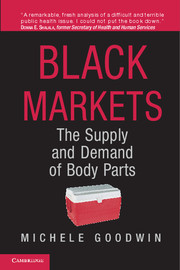Book contents
- Frontmatter
- Dedication
- Epigraph
- Contents
- Miscellaneous Frontmatter
- Preface
- Acknowledgments
- BLACK MARKETS
- PART ONE UNDERSTANDING THE STRAIN ON ALTRUISM
- PART TWO LEGAL FRAMEWORKS AND ALTERNATIVES
- 5 The Uniform Anatomical Gift Act
- 6 Presumed Consent: The Unsuspecting Donor
- 7 Commoditization: Incentives for Cadaveric Organ Harvesting
- 8 Black Markets: The Supply of Body Parts
- PART THREE CRITIQUING THE SLAVERY AND BLACK BODY MARKET COMPARISON
- Notes
- Bibliography
- Index
6 - Presumed Consent: The Unsuspecting Donor
from PART TWO - LEGAL FRAMEWORKS AND ALTERNATIVES
Published online by Cambridge University Press: 14 September 2019
- Frontmatter
- Dedication
- Epigraph
- Contents
- Miscellaneous Frontmatter
- Preface
- Acknowledgments
- BLACK MARKETS
- PART ONE UNDERSTANDING THE STRAIN ON ALTRUISM
- PART TWO LEGAL FRAMEWORKS AND ALTERNATIVES
- 5 The Uniform Anatomical Gift Act
- 6 Presumed Consent: The Unsuspecting Donor
- 7 Commoditization: Incentives for Cadaveric Organ Harvesting
- 8 Black Markets: The Supply of Body Parts
- PART THREE CRITIQUING THE SLAVERY AND BLACK BODY MARKET COMPARISON
- Notes
- Bibliography
- Index
Summary
INTRODUCTION
Carlos M. Gudino would appear twice in the Los Angeles Times newspaper. The first time would be a kind of turning point or rebirth. He was only 19 years old when he worked on a mural with Jesse Rojas, another young, aspiring artist, trying desperately to move beyond the reach of Los Angeles gang life. Their story, one of a possible triumph or at least a story of hope, would be captured by a bold headline: “Praise for His Art Keeps Young Muralist from Being Walled in by Harsh Gang Life.” A photograph would memorialize Carlos’ gaze of Jesse applying the final brush strokes to the mural of Madonna he helped to create.
The Community Youth Gang Services and the Los Angeles Police Department helped to underwrite the project in an effort to bring calm to a community riddled by gang violence, teen unemployment, and drug transactions. The mural, located at a corner in Los Angeles, California, where Wilmington meets G Street, is considered a tough place, where drug transactions occur nightly and trouble awaits. The project was aimed at helping the community overcome despair and transforming the lives of talented young men with a sincere interest in leaving “gangbanging behind.” Although the L.A. Times article would focus considerably on Jesse's artistic talents, Carlos’ youthful gaze would forever be captured and give the vision of hope.
Five years later, in November 1997, almost to the very day, Carlos would again appear in the same daily newspaper that had previously captured him gazing at the Madonna. His brutal death from 12 bullet wounds to the head and chest, which had occurred earlier in the year, ironically was not the focus of the second article. His death was less newsworthy; too many young men in Los Angeles met similar fates. Instead, the article exposed the surreptitious harvesting of corneas at the local morgue. None of the so-called donors or their families in the investigation provided consent to the local coroner who harvested over 1,000 corneas. The article raised questions about the role race, socioeconomic status, and consent in this controversial process known as presumed or legislative consent. The Los Angeles Times contacted Carlos M. Gudino's family the second time as part of a study they were conducting to confirm whether families were aware that their deceased relatives’ corneas had been harvested and later sold.
- Type
- Chapter
- Information
- Black MarketsThe Supply and Demand of Body Parts, pp. 117 - 148Publisher: Cambridge University PressPrint publication year: 2006



